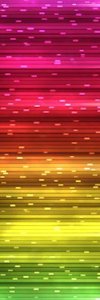
|
RYB Color Model Standards
RYB (an abbreviation of red-yellow-blue) is a historical set of colors used in
subtractive color mixing, and is one commonly used set of primary colors. It is
primarily used in art and design education, particularly painting.
It predates much of modern scientific color theory, which has demonstrated that
magenta, yellow, and cyan is the best set of three colorants to combine, for
the widest range of high-chroma colors. Red can be produced by mixing
magenta and yellow, blue can be produced by mixing cyan and magenta, and green
can be produced by mixing yellow and cyan. In the RYB model, red takes the
place of magenta, and blue takes the place of cyan.
RYB (red-yellow-blue) make up the primary color triad in a standard artist's
color wheel. The secondary colors purple-orange-green (sometimes called
violet-orange-green) make up another triad. Triads are formed by 3 equidistant
colors on a particular color wheel. Other common color wheels represent the
light model (RGB) and the print model (CMYK).
In his experiments with light, Isaac Newton recognized that colors could be
created by mixing color primaries. In his Opticks, Newton published a color
wheel to show the geometric relationship between these primaries. This chart
was later confused and understood to apply to pigments as well, though Newton
was also unaware of the differences between additive and subtractive color
mixing. The RYB model was used for printing, by Jacob Christoph Le Blon, as
early as 1725.
Starting from Goethe, it was increasingly understood that mixing of colored
light in the eye is a process different from mixing of dyes. Subsequently,
German and English scientists established in the late 19th century that color
perception is best described in terms of a different set of primary colors -
red, green and blue (RGB) modeled through the additive, rather than
subtractive, mixture of three monochromatic lights, also known as spectral
colors.
Return
|
